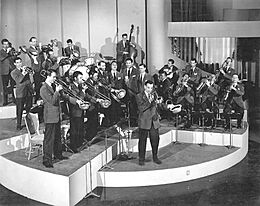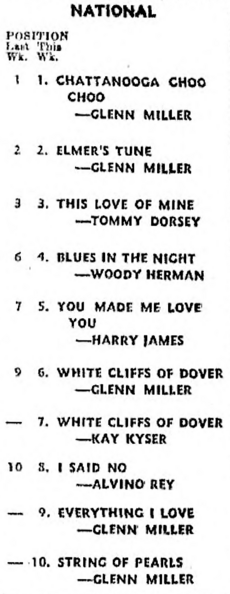Glenn Miller Orchestra facts for kids
Quick facts for kids
Glenn Miller and His Orchestra
|
|
|---|---|

Glenn Miller and His Orchestra, on the set of Sun Valley Serenade, 1941
|
|
| Background information | |
| Genres | Dance band, Swing |
| Years active | April 1938 – September 1942 |
| Labels |
|
Glenn Miller and His Orchestra was a super popular American swing dance band. Glenn Miller started it in 1938. The band had a special sound. It used a clarinet and a tenor saxophone playing the main tune. Three other saxophones played the harmony.
This band became the most popular and successful dance orchestra of the swing era. They had many hit songs in the 20th century. Ray Anthony is the last known surviving member of the original orchestra.
Glenn Miller started recording music professionally in the late 1920s. He played with other musicians in New York City. He learned a lot about arranging music. He wrote music for famous artists like Artie Shaw and Benny Goodman. Miller also studied with music expert Joseph Schillinger. This helped him become even better at arranging.
In 1937, Miller formed an orchestra that made some records. He tried out a new sound with a clarinet. This sound later became known as the Glenn Miller sound. He soon started a new band in 1938.
Contents
The Rise to Stardom
Glenn Miller teamed up with Eli Oberstein. This led to a contract with Bluebird Records. The band became very famous. They played at places like the Paradise Restaurant and Meadowbrook. Their performances were broadcast on radio across the country.
In the summer of 1939, they played at the Glen Island Casino. This made them even more popular. From late 1939 to mid-1942, Glenn Miller's band was the number one band in the USA. Few other bands could match their fame.
The band had an amazing number of hit songs. They had 16 songs that reached number one on the charts. They also had 69 songs in the Top Ten. This was a huge success for such a short time. The band officially stopped playing together in September 1942.
How the Band Began
By March 1938, Glenn Miller was planning his new band. He brought back some musicians he knew well. These included Hal McIntyre, Paul Tanner, Wilbur Schwartz, and Ray Eberle. His old friend Chummy MacGregor also joined. Miller was very determined and good at business. He had a great ear for music. These qualities helped him find people to invest in his band.
The band used Miller's special 'clarinet-lead' sound. This sound quickly caught the attention of college students. They played their first show on April 16, 1938, in Boston. When they came to New York, they were not the main act. But soon, things changed. Marion Hutton joined as a singer. She brought lots of energy to their shows. On September 7, 1938, the band made their first recordings. These included "My Reverie" and "King Porter Stomp".
Playing at Famous Venues
In March 1939, Glenn Miller's Orchestra got a big chance. They were chosen to play for the summer at the famous Glen Island Casino. This casino was in New Rochelle, New York. Before that, they played at The Meadowbrook Ballroom. The band was a big hit there. They were so popular that their stay was extended.
During this time, they recorded more songs for Bluebird. Glenn added drummer Maurice Purtill and trumpeter Dale "Mickey" McMickle. These new members made the band even stronger. When they opened at Glen Island on May 17, 1939, their music was heard all over the country. This was thanks to the casino's radio antenna. By the end of the summer, everyone knew about them.
George T. Simon, a music writer, said that Glen Island was a very important place for bands. He mentioned that the band's first hit, "Little Brown Jug", came out then. He also said the clarinet sound was "romantic." But the most important thing was recording "In the Mood" at the casino. He said that song made Miller the "Michael Jackson of his day."
Becoming Nationally Popular
Miller's band became very popular. He decided to add more instruments to make the sound even richer. On April 4, 1939, they recorded "Moonlight Serenade". This song is one of the top songs of the swing era. It became the band's theme song. They used it to start and end all their radio shows.
The band's most famous song, "In the Mood", was recorded on August 1, 1939. It's known for its catchy opening and bass parts. It also has exciting saxophone solos by Tex Beneke and Al Klink. The song hit number one on the Billboard charts and stayed there for 30 weeks!
Joe Garland put the song together from other tunes. Glenn Miller bought the song in June 1939. He asked Eddie Durham to arrange it for his orchestra. Miller made the final changes himself. Trombonist Paul Tanner remembered recording the song. He said Glenn Miller would tell them what to play. He would also decide where to make the music softer or louder. The dancers loved it! They couldn't figure out how the band knew when to play loud again. Paul said it was because the drummer would hit a cowbell.
On February 5, 1940, Miller recorded "Tuxedo Junction". This song also hit number one. It sold 115,000 copies in its first week! This was a huge number back then. In April, "Pennsylvania 6-5000" was released. This song was about the phone number for the Hotel Pennsylvania. The band often played and broadcast from there. It quickly became a classic swing song.
In early 1941, the band faced a challenge. Radio stations stopped playing songs from ASCAP. This was because of a fight over money. Miller had to change his radio shows to use songs from BMI. He even changed his theme song for a while.
Around this time, Marion Hutton left the band for a short time. Miller hired The Modernaires from Paul Whiteman's orchestra. The Modernaires were a vocal group. They were very popular with young people. They added a new and exciting sound to Miller's music.
In late March, Miller and his orchestra started their first movie. It was called Sun Valley Serenade. Glenn Miller wanted the movie's story to be about the band. Not just have the band play songs. Harry Warren and Mack Gordon wrote songs for the film. The band filmed a big song and dance number with the Nicholas Brothers. This became their biggest selling record, "Chattanooga Choo Choo". Critics liked the film and praised Miller's band.
The First Gold Record
In October, the radio stations and ASCAP agreed on new rules. The band could finally play "Chattanooga Choo Choo" and their other hits on the radio. On February 10, 1942, Glenn Miller received the first gold record ever made! It was for "Chattanooga Choo Choo."
A man named W. Wallace Early gave it to him. He said it had been 15 years since any record sold a million copies. "Chattanooga Choo Choo" sold over 1.2 million copies! Glenn Miller thanked everyone, especially the band.
In early 1942, the band started working on their second movie. It was called Orchestra Wives. Again, Gordon and Warren wrote the songs. They had written "At Last" the year before. This song was featured in Orchestra Wives. It became a very famous song.
Another song from the movie, "(I've Got a Gal In) Kalamazoo", was also a big hit. It featured the Nicholas Brothers again. This song also sold over a million copies. Billboard magazine said it was one of the most popular records of the year.
Joining the War Effort
In mid-July, Miller and the band recorded thirteen more songs. After this, a recording ban started. This meant Miller could not make any new records. But his last songs were still released. "That Old Black Magic" even hit number one in May 1943. This was eight months after his orchestra had stopped playing.
After the Attack on Pearl Harbor in December 1941, Miller started putting more patriotic themes into his shows.
At the peak of his career, Glenn Miller decided to join the military. He was 38 years old, too old to be drafted. He first tried to join the Navy, but they didn't need him. Then he wrote to an Army General. He convinced the United States Army to let him lead a modern Army band. He started his duty on October 7, 1942. He later joined the United States Army Air Forces. There, he formed the Major Glenn Miller Army Air Forces Orchestra. This band was a early version of today's The Airmen of Note.
Glenn Miller and his Orchestra played their last radio show on September 24, 1942. Miller announced that Harry James would take over the show. They played their very last concert on September 27, 1942, in Passaic, New Jersey.
Radio's Role in Success
Radio was super important for Glenn Miller and His Orchestra. They were often on the radio. Many of their early shows were broadcast from places like the Paradise Restaurant and Glen Island. These were heard across the country on the National Broadcasting Company.
Chesterfield Cigarettes sponsored a radio show. The "King of Jazz" Paul Whiteman hosted it. When Whiteman retired, he suggested Glenn Miller as his replacement. On December 27, 1939, Miller took over the show. It was called Chesterfield Moonlight Serenade. The show was very popular. Miller and his band kept the spot until they stopped playing in 1942.
In 1940, the band started broadcasting from the Café Rouge at the Hotel Pennsylvania. This became a regular place for them to play. By then, Miller's band was on the radio almost every day of the week. They reached homes all over America.
Chart-Topping Hits
Glenn Miller and His Orchestra had 121 songs that made it onto the music charts. A total of 69 of these songs were in the Top Ten. And 16 songs reached the number one spot!
In just four years, Miller's songs spent a total of 664 weeks on the charts. That's almost 13 years! And 79 of those weeks were at number one.
Miller also had three albums that reached number one after he passed away. These were Glenn Miller in 1945, its follow-up in 1947, and his original recordings for The Glenn Miller Story movie in 1954.
Million-Selling Singles
Here are some of the songs that sold over a million copies:
- 1939: "Little Brown Jug"
- 1939: "Moonlight Serenade"
- 1939: "In the Mood"
- 1940: "Tuxedo Junction"
- 1940: "Pennsylvania 6-5000"
- 1941: "Chattanooga Choo Choo"
- 1941: "A String of Pearls"
- 1941: "Moonlight Cocktail"
- 1942: "American Patrol"
- 1942: "(I've Got a Gal In) Kalamazoo"
See also
Images for kids



